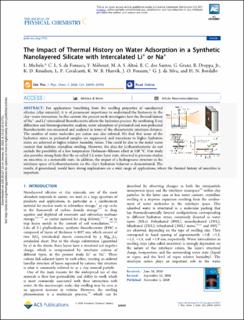The Impact of Thermal History on Water Adsorption in a Synthetic Nanolayered Silicate with Intercalated Li+ or Na+
Michels Brito Miranda, Leander Edward; Fonesca, C. L. S. da; Méheust, Y.; Altoé, M. A. S.; Santos, E. C. dos; Grassi, G.; Droppa Jr., R.; Knudsen, Kenneth Dahl; Cavalcanti, Leide Passos; Hunvik, Kristoffer William Bø; Fossum, Jon Otto; Silva, G.J. da; Bordallo, H. N.
Peer reviewed, Journal article
Published version
Permanent lenke
https://hdl.handle.net/11250/2729318Utgivelsesdato
2020Metadata
Vis full innførselSamlinger
- Institutt for fysikk [2677]
- Publikasjoner fra CRIStin - NTNU [37703]
Originalversjon
Journal of Physical Chemistry C. 2020, 124 (45), 24690-24703. 10.1021/acs.jpcc.0c05847Sammendrag
For applications benefitting from the swelling properties of nanolayered silicates (clay minerals), it is of paramount importance to understand the hysteresis in the clay–water interaction. In this context, the present work investigates how the thermal history of Na+- and Li+-intercalated fluorohectorite affects the hydration process. By combining X-ray diffraction and thermogravimetric analysis, water adsorption of preheated and non-preheated fluorohectorite was measured and analyzed in terms of the characteristic interlayer distance. The number of water molecules per cation was also inferred. We find that some of the hydration states in preheated samples are suppressed, and transitions to higher hydration states are achieved at higher relative humidity values. This could be due to the initial water content that facilities crystalline swelling. However, the data for Li-fluorohectorite do not exclude the possibility of a low temperature Hofmann–Klemen effect at 150 °C. Our study also provides strong hints that the so-called 1.5 water layer state, observed in previous studies on smectites, is a metastable state. In addition, the impact of a hydrogenous structure in the interlayer space of Li-fluorohectorite on the clay’s hydration behavior is demonstrated. The results, if generalized, would have strong implications on a wide range of applications, where the thermal history of smectites is important.

